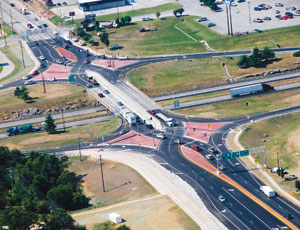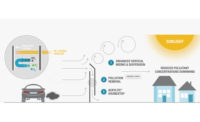The Missouri Dept. of Transportation is building its second “diverging diamond” interchange design that requires motorists at an interchange to temporarily drive on the left side of the road. It was devised by an engineer in graduate school who wasn’t aware the concept already existed in Europe. The Federal Highway Administration has tested and presented the design, and a dozen states are considering using it

The design calls for the approach road on either side of the interchange to curve to the left, so the driver can easily enter the highway on a limited-access ramp without fear of oncoming traffic from the other side of the road. Through-traffic continues on the left side of the road until reaching a second stoplight, where it shifts back to the more familiar right side.
Gilbert Chlewicki, now a senior transportation engineer with the Baltimore office of Dewberry, came up with the idea for a term paper in 2000. Later, on a family visit to France, the tour bus went through a DD interchange in Versailles, he recalls. “I was in total shock,” he says. However, it verified the potential use of the design in the U.S., he adds.
Thanks to a Transportation Research Board symposium in 2003, FHWA task manager Joe G. Bared learned of the design. He tested the concept in FHWA’s driving simulation laboratory in Fairbanks, Va. “I conducted thorough analysis..and published a few papers on the simulation and traffic patterns,” he says. Three sites in Europe had half the number of crashes in a five-year period than comparable sites in the U.S., he notes.
The DDI design provides a theoretical safety benefit because it eliminates potential crossing conflicts between vehicles turning left onto the highway and opposing arterial traffic. One of the greatest safety concerns was the possibility of bearing to the right at the crossovers, despite geometric marking and signage cues to induce drivers to bear left. But a driving simulation experiment using actual drivers alleviated that concern, says Bared.
The Kansas City office of MoDOT considered using the design, but the first one was built in Springfield, replacing an existing interchange. “I thought it would be a good fit,” says MoDOT project manager Don Saiko. “We went for it.”
Local contractor Hartman Construction started construction on the first DDI interchange at Route 13 and Interstate 44 in January and finished in July—approximately half the time it would have taken to rebuild a conventional interchange. “It cost $3.2 million, and tearing down the whole bridge would have been at least $10 million,” Saiko notes.
Crossing the bridge, oncoming traffic is on the right, separated by concrete barriers and screening. This gives left-turning vehicles unimpeded access to the intersecting roadway. At the same time, through traffic is able to travel more steadily through the interchange. Signs, pavement markings and concrete islands clearly guide drivers and help prevent them from making a wrong turn into the opposing lanes.
The interchange handles 40,000 daily vehicles, including visitors to weekend fairgrounds. “Before, it backed up easily half a mile or more,” says Saiko. “Now there is practically zero backup.” So far, Bared says the interchange has a 35% reduction in accidents, though “we need more of these sites and longer time frames to get statistically reliable analysis.”
The second DDI now is under construction in Springfield, on Route 60. That $7.5-million job is slated for completion in August. The Utah Dept. of Transportation also is building one. “We’ve had more than a dozen expressions of interest” from other states, says Bared.
But Bared cautions that when the traffic flow is balanced equally in each direction with a high volume, a DDI design is not ideal. “It works best when the left-turning volume is heavy from the cross road onto the freeway,” he notes.
He says the design typically saves about $5 million compared to widening a conventional diamond interchange. “We don’t have to build new bridges with this design, and they don’t have to be wider,” Bared says.







